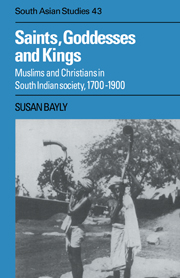Book contents
- Frontmatter
- Contents
- List of plates
- List of maps
- Preface
- Note on transliteration
- List of abbreviations
- Introduction
- Part I
- 1 South Indian religion and society
- 2 The development of Muslim society in Tamilnad
- 3 The Muslim religious tradition in south India
- 4 The south Indian state and the creation of Muslim community
- 5 Warrior martyr pirs in the eighteenth century
- 6 The final period of nawabi rule in the Carnatic
- Part II
- Select glossary
- Bibliography
- Index
- CAMBRIDGE SOUTH ASIAN STUDIES
- Plate section
2 - The development of Muslim society in Tamilnad
from Part I
Published online by Cambridge University Press: 04 December 2009
- Frontmatter
- Contents
- List of plates
- List of maps
- Preface
- Note on transliteration
- List of abbreviations
- Introduction
- Part I
- 1 South Indian religion and society
- 2 The development of Muslim society in Tamilnad
- 3 The Muslim religious tradition in south India
- 4 The south Indian state and the creation of Muslim community
- 5 Warrior martyr pirs in the eighteenth century
- 6 The final period of nawabi rule in the Carnatic
- Part II
- Select glossary
- Bibliography
- Index
- CAMBRIDGE SOUTH ASIAN STUDIES
- Plate section
Summary
Introduction
The preceding chapter sought to show that pre-colonial south India was far from being a bastion of high Brahmanical orthodoxy. State power and religion were becoming ever more closely intertwined in the seventeenth and eighteenth centuries. Techniques of statecraft were eclectic, and the dynamic new regimes of the south offered their patronage to an extremely wide range of shrines and holy places. As a result, south Indian ‘Hinduism’ – or the traditions which were forming into something which we now identify as formal Hinduism – was neither stultified nor monolithic at this time. Even though there was a broad trend towards more lavish forms of temple-centred religion, there were no clearcut boundaries between Sanskritic temple worship, the bhakti cult tradition, and the so-called Hindu ‘folk’ tradition with its peys, pattavans and blooddrinking amman goddesses: all these forms of faith and worship came to overlap and invigorate one another. The result was not a progressive standardising of religious life and a trend towards textual ‘orthodoxy’ and ‘high culture’, but a process of mutual stimulation. All areas of religious life were enriched and revitalised by this process of exchange.
What then of the large numbers of Tamils and Malayalis who took on some form of Muslim affiliation in the pre-colonial period? According to the 1901 Census of India, the Tamil country contained nearly 830,000 Muslims out of a total population of just under twenty million. Assuming a total population of about twelve million in 1800, this would mean that there were about 600,000 professing Muslims in the Tamil country at the end of the eighteenth century.
- Type
- Chapter
- Information
- Saints, Goddesses and KingsMuslims and Christians in South Indian Society, 1700–1900, pp. 71 - 103Publisher: Cambridge University PressPrint publication year: 1990



